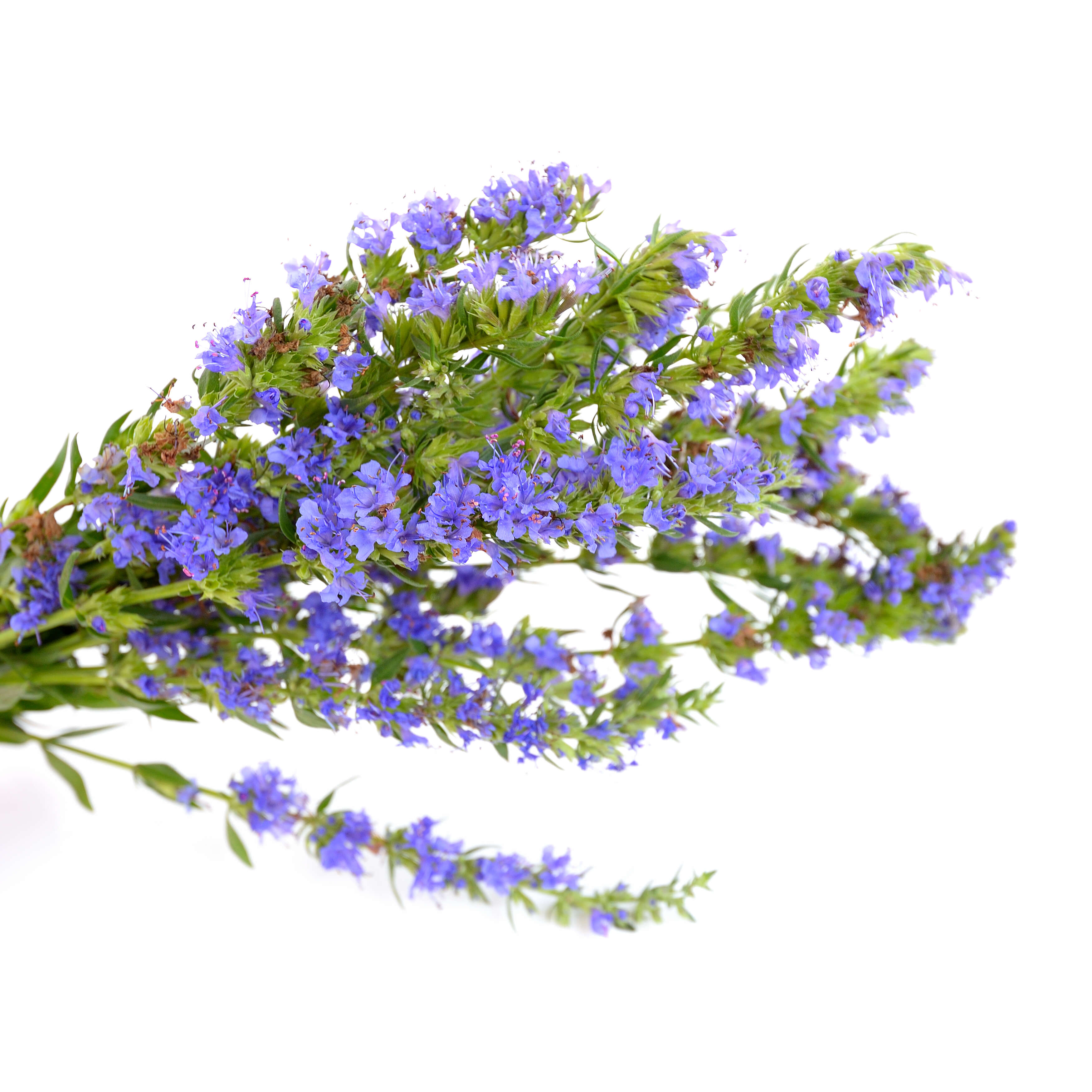Hyssop EO
Naturelle
Herbal > Camphoric > Coniferous > Agrestic > Grassy

Crédits photo: ScenTree SAS
Latin name :
Hyssopus officinalis
Botanical profile :
Hyssop is a perennial shrub belonging to the Lamiaceae family (as Patchouli EO or Spearmint EO for example), and of the genus Hyssopus.
Geographic origin :
Originally from the Mediterranean region, hyssop is today cultivated mainly in Southern Europe (especially ex-Yugoslavia and Spain), in North Africa, and in North America since its importation.
Chemotypes :
Hyssopus officinalis is the only hyssop cultivated for its olfactory interest. Nevertheless, it comprises three major varieties :
Hyssopus officinalis ssp. officinalis, whose composition varies according to its country of origin - in ex-Yugoslavia, its composition is rich in Methyl Eugenol and D-Limonene; in Spain, it is rich in Eucalyptol; moreover, it is mainly composed of iso-pinocamphones.
Hyssopus officinalis ssp.canescens, grown in the south of the Alps, rich in Eucalyptol and Linalool.
Hyssopus officinalis ssp. aristatus, grown in Bulgaria and Spain, rich in Eucalyptol and iso-pinocamphones.
Hyssopus decubens, from Lure in Haute-Provence, rich in Linalool and Linalool Oxide.
Hyssopus officinalis ssp. officinalis, whose composition varies according to its country of origin - in ex-Yugoslavia, its composition is rich in Methyl Eugenol and D-Limonene; in Spain, it is rich in Eucalyptol; moreover, it is mainly composed of iso-pinocamphones.
Hyssopus officinalis ssp.canescens, grown in the south of the Alps, rich in Eucalyptol and Linalool.
Hyssopus officinalis ssp. aristatus, grown in Bulgaria and Spain, rich in Eucalyptol and iso-pinocamphones.
Hyssopus decubens, from Lure in Haute-Provence, rich in Linalool and Linalool Oxide.
Extraction process :
Hyssop grows in fairly dry, well-drained soil. Propagation of the plants is done by sowing seeds during spring, or by cutting old clumps, always during this season. Usually, the first plants appear in autumn, a few months after planting. It can be directly cultivated.
As the essential oil is mainly contained in the leaves, the stems are cut manually in the morning at their base when the flowers are open to three quarters of their potential. The plants are then left to dry before extraction.
Extraction is carried out in a distillation tank, under steam pressure. The essential oil is recovered by settling over the water in a Florentine vase, after cooling the vapours.
Yield for hyssop essential oil is of 0,15%. This can explain the price of this oil.
As the essential oil is mainly contained in the leaves, the stems are cut manually in the morning at their base when the flowers are open to three quarters of their potential. The plants are then left to dry before extraction.
Extraction is carried out in a distillation tank, under steam pressure. The essential oil is recovered by settling over the water in a Florentine vase, after cooling the vapours.
Yield for hyssop essential oil is of 0,15%. This can explain the price of this oil.
Major Components :
For Hyssopus officinalis ssp. officinalis species :
Iso-pinocamphone (30-35%)
Beta-Pinene (15-25%)
Pinocamphone (10-15%)
Phenol methyl ether (≈4%)
Beta-Caryophyllène (≈3%)
Myrtenol Methyl Ether (≈3%)
Iso-pinocamphone (30-35%)
Beta-Pinene (15-25%)
Pinocamphone (10-15%)
Phenol methyl ether (≈4%)
Beta-Caryophyllène (≈3%)
Myrtenol Methyl Ether (≈3%)
- Uses in perfumery :
- Used in lavender and lavandin accords, to give a natural effect, in small quantities. Also brings a hay and warm side to fougere-type perfumes.
- Other comments :
- The iso-pinocamphones in this essential oil are neurotoxic. This explains why hyssop essential oil is almost exclusively used in perfumery, in small quantities.
- Volatility :
- Heart
- Appearance :
- Yellow liquid
- Stability :
- Terpenes found in this oil may polymerize under a strong oxydation.
- Price Range :
- €€€
- Aromatherapy :
Informations provided below are taken from reference works in aromatherapy. They are given for information purposes only and can not constitute medical information, nor engage the responsibility of ScenTree.
Hyssop essential oil is known to be anticatarrhal (inflammation of the mucous membranes), viricidal (against viruses) and bactericidal. It is recommended in cases of pneumonia, bronchitis, flu, cystitis and multiple sclerosis in particular.

Crédits photo: ScenTree SAS
- EINECS number :
- 84603-66-7
- FEMA number :
- 2591
- Allergens :
- D-Limonene
- IFRA :
- This ingredient is not restricted
To learn more about IFRA's standards : https://ifrafragrance.org/safe-use/library
ScenTree is solely responsible for the information provided here.

